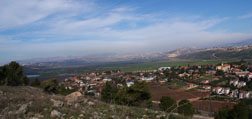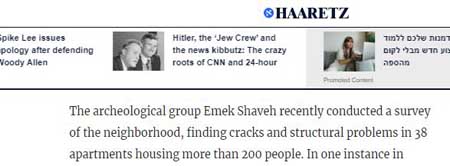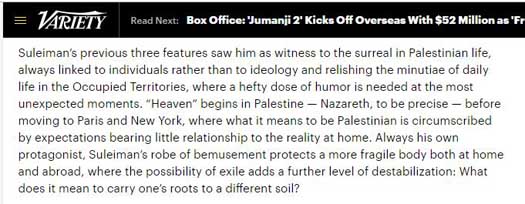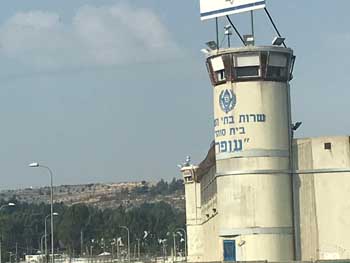Recent Entries:
Author: TS
August 10, 2021
AFP Arabic Stops Mislabeling Northern Israeli Communities ‘Settlements”
A view of Metulla, northern Israel (Photo by Hadar Sela)Throughout last week’s round of escalation between Israel and Lebanon, AFP’s Arabic coverage consistently refrained from using this term when mentioning Kiryat Shmona, calling it “a town” instead. In comparison, between May 14 and 19, AFP referred to nearby Metula as “a settlement” no less than three times.
Notably, in recent months CAMERA Arabic prompted several Arabic news outlets to correct the “settlement” terminology with regards to Jewish communities inside Israel’s internationally recognized territory: BBC, Reuters and EuroNews.
June 17, 2020
Haaretz Applies Inconsistent Standards to NGOs
A news story in Haaretz‘s English edition yesterday applied a double standard in its treatment of NGOs (“Fearing structural collapse, Israel halts dig in East Jerusalem,” page 3, and online here.)
Nir Hasson’s online article cited the “right-wing, settler Elad Association.” Similarly, the print edition mentions “the right-wing Elad Association.”
In contrast, when the article mentioned “The archeological group Emek Shaveh” it did not identify the organization as “left-wing” even though it has a clear left-wing agenda. Why the double standard?
If the political leanings of one organization is mentioned, then the leanings of the opposing organization should also be mentioned. Alternatively, if Emek Shaveh’s political inclinations aren’t mentioned, then why insert Elad’s?
Nir Hasson’s Hebrew article does not include political descriptions of either organization.
See also, “Haaretz, Lost in Translation“
June 2, 2020
Reuters Arabic Misidentifies Dome of Rock
The following photo and caption appeared in the Arabic version of an article by Reuters’ Stephen Farrell, published on April 24 and dedicated to the opening Friday of Ramadan in the Old City of Jerusalem:
The Arabic reads: “Jerusalem’s Al-Aqsa Mosque with the Dome of the Rock behind it – a picture from the Reuters archive.”
However, the dome shown in the back of the photo belongs to the mosque itself, while the Dome of the Rock does not appear at all in the picture as is located behind the camera.
Notably, the English version of the same article is accompanied by a different photo and does not contain the error.
Given the great importance of both buildings to Muslims worldwide, it is rather striking that editors of Reuters’ Arabic service made this error. CAMERA had notified editors of the error, and yet they have failed to correct.
December 10, 2019
AP Distorts: Bethlehem ‘Almost Completely Surrounded’
Over two years after improving inaccurate language falsely citing Israel’s security “barrier surrounding the biblical city” of Bethlehem, the Associated Press once again misrepresents.
AP’s Joseph Krauss and Mohammad Daraghmeh wrote yesterday (“Palestinians in Bethlehem look beyond religious tourism“):
Bethlehem itself is almost completely surrounded by the barrier and a string of Jewish settlements
The Peace Now map shown below clearly shows where the barrier exists (solid red line) or is planned (dotted red line) on the northern and western sides of Bethlehem. On the south east, there are the settlements (solid pinks blocks) of Tekoa, Nokdim and Sde Bar. To the north and west of this block of settlements there are significant stretches with no barrier and no settlements. (The block with red lines, dubbed Givat Eitam, due south of Bethlehem, is slated for Israeli construction, according to Peace Now’s map.)
In December 2016, AP’s Isma’il Kushkush accurately referred to “the concrete barrier that surrounds part of Bethlehem.”
Given that neither the barrier nor settlements abut significant portions to the east and south of the city, AP’s description of Bethlehem as “almost completely surrounded by the barrier and a string of Jewish settlements” is unfounded.
Dec. 11 Update: “Times of Israel Corrects AP Error on ‘Surrounded’ Bethlehem”
December 10, 2019
Variety Redraws Israel’s Map
“Variety is the most authoritative and trusted source of entertainment business news,” boasts its web site but readers should not have any expectations about the accuracy of its geopolitical coverage. A May 2019 movie review which just came to our attention erroneously placed the northern Israeli city of Nazareth in “Palestine.”
Asserting that movie director Elia Suleiman, “the eternal observer, trusts his audience to know the facts,” Variety’s Jay Weissberg gets the facts wrong, erroneously reporting: “‘Heaven’ begins in Palestine — Nazareth, to be precise . . . ” (“Film Review: ‘It Must Be Heaven,’” May 24, 2019).
Nazareth is a city in northern Israel, within the undisputed pre-1967 boundaries of the country. It is not in “Palestine,” the West Bank or the occupied territories, as this United Nations map makes clear.
Hat tip: Tomer Ilan
November 5, 2019
Reuters Errs on Administrative Detention For ‘Anti-Israel Activity’
The Ofer Prison, near Ramallah (Photo by Tamar Sternthal)A Reuters article today egregiously misrepresents administrative detention, erroneously asserting that it is mainly applied to “Palestinians suspected of anti-Israeli activities,” when in fact the Israeli practice applies in cases of suspected security offenses. The Nov 4. article (“Jordan says two citizens held in Israel to return ‘before the end of the week’“) errs:
Israel mainly uses “administrative detention”, or imprisonment without trial, against Palestinians suspected of anti-Israeli activities. (Emphasis added.)
The identical error also appears in this earlier Oct. 29 article.
Israel does not mainly use administrative detention against Palestinians suspected of “anti-Israeli activities” generally. Rather, the measure may only be applied in cases of suspicion regarding security-related offenses.
Thus, B’Tselem, an NGO highly critical of Israeli government policies and activity in the West Bank, explains:
In the West Bank (not including East Jerusalem), administrative detention is carried out under the Order regarding Security Provisions. The order empowers the military commander of the West Bank, or another commander to whom the power has been delegated, to place individuals in administrative detention for up to six months at a time, if the commander has “reasonable grounds to believe that reasons of regional security or public security require that a certain person be held in detention”.
The Associated Press, another leading wire service, accurately described administrative detention yesterday, stating that the two Jordanian citizens to be released later this week
are being held in administrative detention, an Israeli policy that allows for open-ended detentions without filing charges against people suspected of security offenses.
CAMERA has contacted Reuters to request a clarification. Stay tuned for an update.
October 6, 2019
In English, Haaretz Whitewashes Temple Mount Killings
Master Sgt. Kamil Shnaan, left, and Master Sgt. Haiel Sitawe, right, the police officers killed in the terror attack next to the Temple Mount complex in Jerusalem on July 14, 2017. (Israel Police)In an article last week on the occasion of IDF’s Brig. Gen. Eran Niv wrapping up his post as commander of the Judea and Samaria Division, Haaretz‘s English edition whitewashes the July 2017 killing of two Druze police officers shot dead by three Israeli Arab assailants just outside the Temple Mount.
Haaretz‘s English edition, both in print (page 4, Sept. 29) and online refer to the “deaths of two Border Police officers” in the summer of 2017:
The perceived violation of religious symbols is a particularly potent accelerant for violence, Niv says, recalling the violence that erupted after Israel installed metal detectors at the Temple Mount in the summer of 2017, following the deaths of two Border Police officers, as well as the brief outburst that followed visits by Jews to the Temple Mount in August on Tisha B’Av, which coincided with the Muslim holiday of Eid al-Adha. (Emphases added.)
Why does the English edition fail to note that the border police officers were killed by Israeli Arab assailants leaving the Temple Mount? Indeed, violence didn’t erupt only after the officers’ “deaths” — their deaths themselves, ie murders, were violent.
The Hebrew version of the same article more precisely reported that the officers were killed (CAMERA’s translation):
Niv identifies several negative accelerants which could contribute to an escalation: blood, the harming of religious symbols and nationalist friction between Palestinians and settlers. The religious element is particularly sensitive. The storm over the installation of metal detectors, after the killing of two border policemen at the Temple Mount in the summer of 2017, was a good example. In August [2019], we experienced a brief escalation following Palestinian rage, when Jews went up on the mount on Tisha B’Av — which coincidentally overlapped with Eid al-Adha.
See here for more instances of “Haaretz, Lost in Translation,” in which the English edition downplays, whitewashes or omits instances of Arab violence or other wrongdoing which were reported in the parallel Hebrew article.
September 24, 2019
Media Confounds, Calling Israel’s Voting Arab Citizens ‘Palestinian’
Arab woman voting in Jaffa, 2013 (Photo by Noam Moskovich/The Israel Project (Flickr)The impressive turnout on the part of Arab citizens of Israel in last week’s elections — making the Joint List of Arab parties the country’s third largest party and placing it in position to lead the opposition — garnered significant media coverage. Some media outlets, unfortunately, provided confusing coverage by insisting on referring to Israel’s Arab voting population as “Palestinians,” despite the fact that they are Israeli citizens, they do not reside in Palestinian controlled areas, and the overwhelming majority of them do not identify as Palestinian.
Particularly in the context of Arab citizens exercising their right to vote in Israeli elections, the “Palestinian” label is unjustified and misleading.
In The New York Times, for example, bureau chief David Halbfinger confounded:
Mr. [Ayman] Odeh’s ads practically beg Palestinian citizens to vote on Tuesday, saying that one million citizens, if they all voted, would translate into 28 seats in the Knesset. . . .
Indeed, such misleading nomenclature for Arab citizens of Israel confuses them with Palestinians — Arabs who live in Palestinian-controlled territories and who do not hold Israeli citizenship. For example, in the same article, Halbfinger refers to “Israel’s treatment of the Palestinians living under the occupation” and also to an Instagram photo of an “iconic Tel Aviv skyscraper with its facade displaying the Palestinian national flag.” How are all but the already well-informed readers meant to unpack this terminology, and distinguish between the voting “Palestinians” versus Arabs in the West Bank or Gaza who are not Israeli citizens?
Indeed, NPR’s Daniel Estrin seems to recognize the problem with referring to Israel’s Arabs as “Palestinian” even as he does so. He refers to “Palestinian Arab citizens of Israel” but then feels compelled to clarify:
And another thing to note here is that the party representing Palestinian Arab citizens of Israel – I’m not talking about the Palestinians of the West Bank and Gaza, they don’t have voting rights in Israel – but the Arab party is poised to be the third-largest party in the Parliament.
Besides confusing uniformed news consumers, referring to Israel’s Arabs as “Palestinians” does not reflect how the vast majority self-identify. A poll released this week by the Guttman Center for Public Opinion and Policy Research at the Israel Democracy Institute found that 13 percent of Israeli Arabs identify primarily as Palestinians. As Haaretz reported:
Nearly two-thirds (65 percent) of Arab citizens said they were proud to be Israelis – the highest rate since 2003. Asked how they self-identify, 38 percent said as Arab, 36 percent said by religion (Muslim, Christian or Druze), 13 percent said as Palestinian and 9.5 percent said as Israeli.
July 24, 2019
CNN Calls House’s Unifying Anti-BDS Vote ‘Divisive’
Yesterday, in an overwhelming vote of bipartisan support, the House of Representatives voted 398 to 17 to adopt a resolution opposing the anti-Israel BDS (boycott, divest, sanctions) campaign. Yet, CNN’s headline casts the unifying vote as divisive, stating: “House approves resolution opposing Israel boycott movement in divisive vote.”
As CNN’s Ashley Killough and Clare Foran rightly reported in the accompanying text:
The House of representatives on Tuesday voted to approve a non-binding resolution that opposed the boycott movement against Israel, a measure that won broad bipartisan support but faced pushback from some high-profile progressives.
AP’s headline underscored: “House opposes Israel boycott in bipartisan vote.”
CAMERA has contacted CNN to request a correction. Stay tuned for an update.
May 29, 2019
In Robert Bernstein Obit, AFP Inappropriately References His Judaism
Robert Bernstein (Courtesy the New Press)In its obituary yesterday for American publisher Robert Bernstein, Agence France Presse inserted an inappropriate reference to the Human Rights Watch founder who later turned on the organization due to its disproportionate fixation on Israel at the expense of closed societies around the world.
The AFP reported:
In 2009, Bernstein — who is Jewish — turned against Human Rights Watch, accusing the organization he helped found in 1978 of being biased against Israel.
How is Bernstein’s Judaism relevant to his objections to what he saw as HRW’s completely disproportionate and unfounded obsession with Israel, at the expense of focus on closed societies elsewhere?
In the UK, the Editors’ Code of Practice states:
Details of an individual’s race, colour, religion, gender identity, sexual orientation, physical or mental illness or disability must be avoided unless genuinely relevant to the story.
The only way mentioning Bernstein’s religion is relevant in this context is to imply his Jewishness helps explain his turning against HRW – which would be an inherently antisemitic allegation.
Update, 9:10 am EST: Times of Israel Removes Inappropriate Reference to Robert Bernstein’s Judaism
Search:
Search this site:













